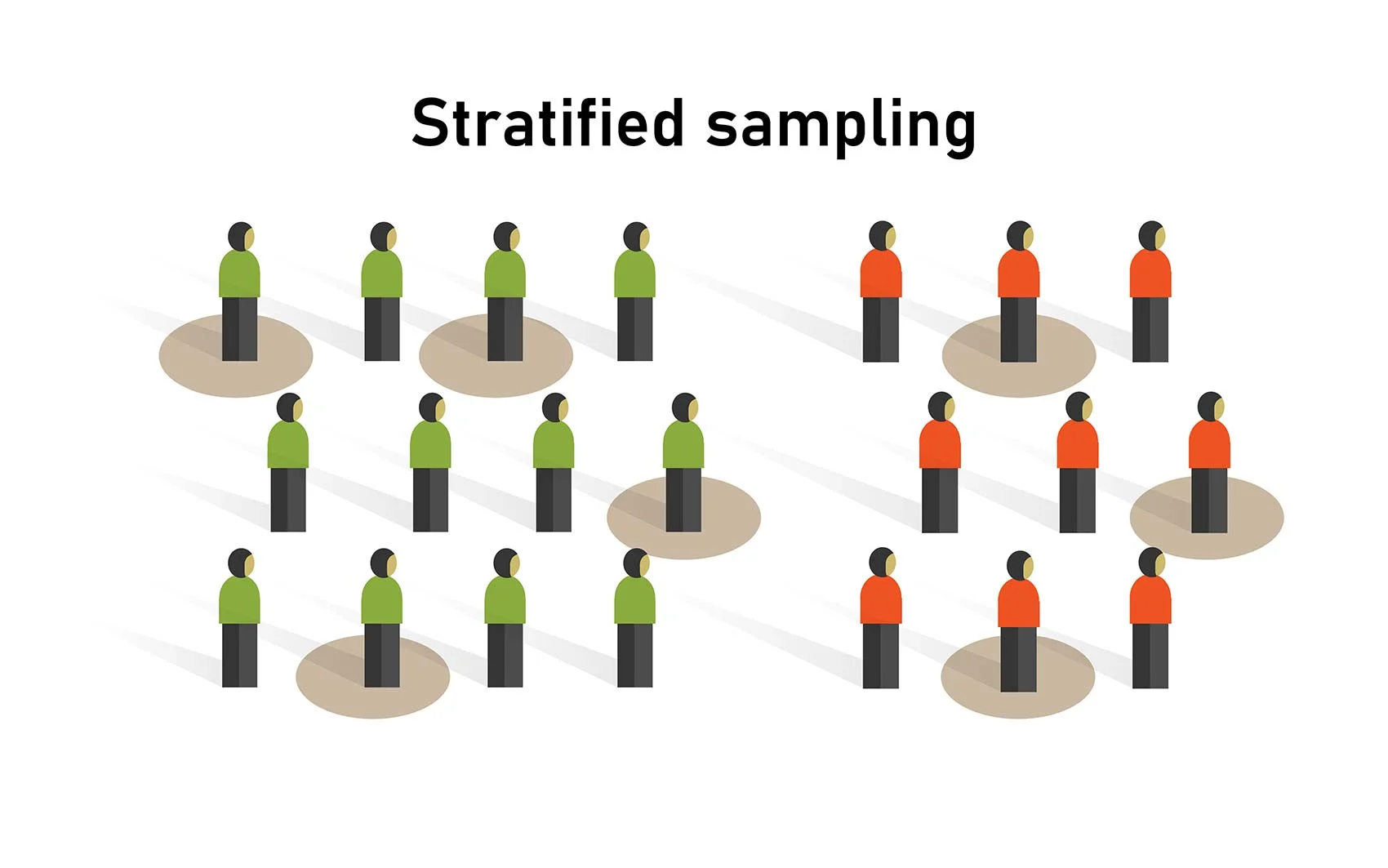A Story of Data Precision
When Dr. Karen Thompson began researching healthcare access in a diverse urban population, she quickly realized that more than traditional sampling methods would be required. The city she was studying was a patchwork of different ethnicities, income levels, and educational backgrounds. To truly understand the disparities in healthcare access, Dr. Thompson needed to ensure that every population segment was accurately represented. That’s when she turned to stratified random sampling. By dividing the population into distinct subgroups and randomly sampling within each group, she could gather data that accurately reflected the diverse experiences of the city’s residents. The results of her study not only provided a clearer picture of healthcare access but influenced policy changes that better served the community.
Dr. Thompson’s experience underscores the power of stratified random sampling in research. This method ensures that all relevant subgroups are represented, providing more accurate and reliable data. In this article, we’ll explore the concept of stratified random sampling, how it works, why it’s essential for research, and its real-world applications.
What is Stratified Random Sampling?
Stratified random sampling is a research technique used to ensure that specific subgroups within a population are adequately represented. The population is divided into distinct strata, or subgroups, based on characteristics such as age, gender, income, education, or ethnicity. Once the population is stratified, random samples are taken from each subgroup, ensuring that the final sample is representative of the entire population.
This method contrasts with simple random sampling, where every individual in the population has an equal chance of being selected. In stratified random sampling, the focus is on ensuring that critical subgroups are proportionally represented, reducing sampling bias and increasing the accuracy of the results.
The Process of Stratified Random Sampling
Stratified random sampling involves several steps:
- Identify the Population: Define the entire population that you want to study. For example, if you are studying the educational attainment of high school students in a city, your population would be all high school students in that city.
- Divide the Population into Strata: Break down the population into distinct subgroups, or strata, based on relevant characteristics. For example, divide the students by grade level, socioeconomic status, or ethnicity.
- Determine the Sample Size for Each Stratum: Decide how many individuals you need to sample from each subgroup. The sample size for each stratum should be proportional to the overall population size. For instance, if one grade level makes up 30% of the population, 30% of your sample should come from that grade level.
- Randomly Select Individuals from Each Stratum: Use a random sampling method to select individuals from each subgroup. This ensures that everyone within a stratum has an equal chance of being included in the sample.
- Combine the Samples: Once you’ve selected individuals from each subgroup, combine them to form your final sample. This sample should be representative of the entire population, accounting for its diversity.
Statistic: According to a study published in the Journal of Statistical Planning and Inference, stratified random sampling can reduce estimate variance by up to 30% compared to simple random sampling, leading to more precise results.
The Benefits of Stratified Random Sampling
Stratified random sampling offers several critical advantages over other sampling methods:
- Increased Accuracy and Precision
By ensuring that all relevant subgroups are proportionally represented, stratified random sampling reduces sampling bias and increases the accuracy of the data. This method is beneficial when the heterogeneous population consists of distinct subgroups with different characteristics.
Pro Tip: Use stratified random sampling when you know that specific subgroups in your population have different experiences, behaviours, or outcomes that need to be captured in your study.
- Better Representation of Subgroups
Stratified random sampling ensures that even small or minority subgroups are adequately represented in the sample. This is especially important in research where the experiences of these subgroups may differ significantly from the majority population.
Example: In political polling, stratified random sampling is often used to ensure that voters from different demographic groups (e.g., age, race, income) are accurately represented, leading to more reliable predictions.
Statistic: A report by the Pew Research Center found that stratified random sampling improves the representativeness of survey results, especially in studies involving diverse populations.
- Cost Efficiency
Stratified random sampling can be more cost-effective than simple random sampling, particularly in large and diverse populations. By focusing on specific subgroups, researchers can gather the necessary data with a smaller overall sample size, reducing the costs associated with data collection.
Pro Tip: Stratified random sampling is ideal for large-scale studies where budget constraints require precise data collection without oversampling.
Real-World Applications of Stratified Random Sampling
Stratified random sampling is widely used across various fields, including social sciences, healthcare, marketing, and political science. Here are some examples of how this method is applied:
- Public Health Research
In public health studies, stratified random sampling is often used to assess health outcomes across different demographic groups. For instance, a survey of the prevalence of diabetes might use stratified sampling to ensure that age, gender, and ethnic groups are proportionally represented. This approach clarifies how diabetes affects different populations, leading to more targeted and effective interventions.
Statistic: According to the Centers for Disease Control and Prevention (C.D.C.), stratified random sampling is a crucial method in the National Health and Nutrition Examination Survey (NHANES), which monitors the health and nutritional status of the U.S. population.
- Political Polling
Stratified random sampling is a cornerstone of political polling. Pollsters use this method to ensure that their samples reflect the electorate’s diversity, accounting for age, race, income, and education. By doing so, they can make more accurate predictions about election outcomes and public opinion.
Example: During the 2020 U.S. Presidential Election, pollsters used stratified random sampling to ensure that voters from crucial swing states and demographic groups were adequately represented, providing insights into voter behaviour and preferences.
- Market Research
Companies use stratified random sampling to understand the preferences and behaviours of different customer segments. For example, a company launching a new product might stratify its target market by age, gender, or income level to ensure that the sample reflects the diversity of potential customers. This approach helps companies tailor their marketing strategies to different segments, increasing the likelihood of a successful product launch.
Statistic: A study by the American Marketing Association found that stratified random sampling improves the accuracy of consumer research, leading to more effective marketing decisions.
Challenges and Limitations of Stratified Random Sampling
While stratified random sampling offers many benefits, it also comes with challenges that researchers need to consider:
- Complexity in Implementation
Stratified random sampling requires detailed knowledge of the population and its subgroups. Identifying the correct strata and ensuring that the sample sizes are proportional can be complex and time-consuming. Researchers must have accurate data on the population to create appropriate strata, which can be a challenge in some studies.
- Risk of Over-Stratification
If the population is divided into too many small strata, it can lead to over-stratification, where each subgroup becomes too small to provide meaningful data. This can reduce the overall effectiveness of the sampling method and lead to difficulties in analysis.
Pro Tip: Balance the need for detailed subgroup representation with the practicality of sample size. Avoid creating too many strata that could dilute the sample.
Conclusion: The Power of Stratified Random Sampling
Stratified random sampling is a powerful tool in research, offering increased accuracy, better representation of subgroups, and cost efficiency. Whether you’re conducting a public health study, political poll, or market research, this method ensures that your data reflects the diversity of the population, leading to more reliable and actionable insights.
As Dr. Karen Thompson’s story illustrates, the precision of stratified random sampling can make all the difference in understanding complex issues and driving meaningful change. By carefully selecting and proportionally representing subgroups, researchers can achieve a deeper and more accurate understanding of their study populations.
In a world where data-driven decisions are more critical than ever, stratified random sampling provides a robust framework for collecting reliable data and uncovering the insights needed to make informed choices.
F.A.Q. Section
Q: What is the difference between stratified and simple random sampling?
A: Stratified random sampling divides the population into subgroups (strata) and random samples within each subset, ensuring proportional representation. Simple random sampling does not consider subgroups and treats the entire population as one unit for random selection.
Q: When should I use stratified random sampling?
A: Use stratified random sampling when your population is heterogeneous and contains distinct subgroups you want proportionally represented in your sample.
Q: What are some typical applications of stratified random sampling?
A: Stratified random sampling is commonly used in public health research, political polling, market research, and studies involving diverse populations.
Q: What are the main challenges of stratified random sampling?
A: The main challenges include the complexity of identifying and creating appropriate strata, the risk of over-stratification, and the need for detailed population data.
Q: Can stratified random sampling reduce sampling bias?
A: Yes, stratified random sampling can reduce sampling bias by ensuring that all relevant subgroups are proportionally represented, leading to more accurate and reliable data.




